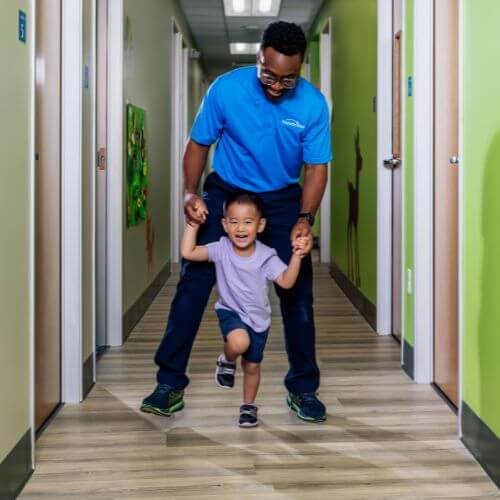Hopebridge Offers Clinicians Free CE Course on Neurodiversity-Affirming Care
April 25, 2024
April 25, 2024

In recent years, conversations around inclusivity, autism acceptance and neurodiversity have gained significant traction, marking a pivotal shift in how society perceives and interacts with autistic individuals and those with differing abilities and behaviors. Yet, amid these discussions, a critical question emerges: Is society truly embracing neurodiversity if the available therapeutic approaches fail to reflect this acceptance?
This question stood at the heart of a free, internal continuing education (CE) course we recently offered our Hopebridge clinicians, “Neurodiversity Affirming Practice: A Practitioner Perspective.” This presentation was designed to bridge the gap between rhetoric and reality in autism intervention and the broader disability spectrum.
Led by Hopebridge Outpatient Fieldwork and Professional Development Advisor Abby Hamilton, MS, OTR/L, the course was geared toward clinicians from diverse backgrounds under one interdisciplinary umbrella.
In case you missed it, here is an insider’s peek into the information our team was able to delve into within this CE event.
In order to provide neurodiversity-affirming care, it’s imperative we understand what “neurodiversity” means and why it is significant within therapeutic services like occupational therapy, speech therapy and applied behavior analysis (ABA). Abby’s presentation covered the term’s history; first coined in 1998 by sociologist, Judy Singer.
It is not a medical term nor is it a diagnosis. Neurodiversity and autism spectrum disorder (ASD) are not synonyms, but autism does fall under the umbrella of neurodiversity, along with other diagnoses. “Neurodivergent” is often used to describe people who have autism or other diagnoses such as attention-deficit hyperactivity disorder (ADHD), dyslexia, dysgraphia and Tourette Syndrome.
According to Harvard Health, neurodiversity describes the idea that individuals experience and interact with the world in a range of ways, rather than one “correct” way of thinking, learning or behaving. It means everyone’s brain functions differently, yet in the neurodiversity movement, these differences are not viewed as deficits.
As such, with a neurodiversity affirming approach, Abby pointed out that, “‘Neurotypical’ is not the goal. We’re not trying to shape them into this neurotypical box, but rather figure out how to work with these differences for therapeutic outcomes.”
Understanding how we got to the neurodiversity movement is important when looking toward the future and preventing some of the same mistakes that have happened in the past. Through Abby’s comprehensive exploration of the historical evolution of disability models, participants gained especially as it relates to autism.
We’ve come a long way from the moral model, viewing disability as a fate, punishment or moral weakness, and the medical model, which viewed disability as a “defect” that should be cured. Recent models like the social model have been more progressive, with disability as a social construct; emphasizing environmental barriers over individual impairments. Most recently, the minority group (sociopolitical) model expanded upon the social model, focused on disabled individuals as the driving force of change in all things related to disability, including research and advocacy.
“As we shift, we see trends change. Disability is no longer thought to be a sin nor stemmed from wrongdoing as it was in the past, and it’s no longer about ‘curing’ neurodiverse people, but instead understanding and ensuring disabled people are valued members of society,” said Abby. “It’s important we have awareness around these brain differences and learn how we can shift in our own practice to accept and celebrate those differences in our children.”
Awareness and education about neurodiversity is one piece of it. Putting it into action through neurodiversity affirming practice is another. During this course, Abby shared a variety of ways participants can apply their knowledge.
She recommends first synthesizing the knowledge by:
“This is a newer movement and there is still a lot of debate around it. There are some absolutes around what neurodiversity-affirming is not – such as some of the old school practices – but there is not only one right way to do it,” said Abby.
Neurodiversity-affirming practices can look like incorporating a child’s special interests into their treatment plans. It is valuing all forms of communication equally, rather than prioritizing vocal speech for the end goal. This practice includes trusting that our kids know their bodies and providing them flexible seating options or making a space for stimming to occur so they can regulate their systems. It may include re-thinking what “functional play” looks like and how you can highlight your child’s way of thinking to address a specific skill. Maybe most importantly, neurodiversity-affirming care is teaching children that when they say “no,” we listen.
Feeling overwhelmed? Abby urged clinicians to give themselves some grace, as it’s a complex subject.
“Use the knowledge to action framework. When we’re given new knowledge, it’s all about learning where those knowledge gaps are. Keep an open mind and be ready to learn and make changes to your practice,” said Abby.
In addition to opening ourselves to this evolution, Abby shared tips for talking to caregivers about neurodiversity. Learning a child has a diagnosis like autism can be a lot to take in for many parents, but there are ways to support them in the educational journey around it.
“Handing caregivers a 10-page research article or telling them to Google it on their own can be overwhelming. I find a lot of parents respond well to or bite-sized PDFs that explain neurodiversity, which can help you start that conversation,” said Abby.
She noted that there are so many resources out there, including conflicting information, and therefore articles and social media accounts given to caregivers should always be well-vetted and share evidence-based strategies. She mentions accounts like therapist and advocate, Kaelynn Partlow, of “Love on the Spectrum,” and Dr. Diamond Rashad provide interesting perspectives on neurodiversity.
From embracing neurodiversity as a core principle to fostering inclusive environments that honor individual differences, clinicians signed off from the course equipped with the tools and mindset needed to effect real change in their practices.
This presentation is just one of many free CEU and training opportunities that Hopebridge offers to its clinicians. With thought leaders on progressive ABA topics like SBT, ACT, total communication in ABA, cultural responsiveness, and trauma-informed care, plus conversations surrounding comorbid conditions, school preparation and even soft skills in supervision, there are always more chances to build knowledge and put it into action through quality, compassionate care. To stay in the know on upcoming CE events, presentations, conferences and more, follow Hopebridge on LinkedIn.
As an industry leader with clinicians around the country, Hopebridge is able to offer a breadth of support and additional career development initiatives. With a Fellowship Program and fieldwork hours for graduate students, an RBT Development Program and BCBA Career Pathway for those wishing to advance in their roles, and ground rounds and mentorship programs for clinicians at any level, the learning never ends.
If you want a career where you can continue to develop your skills while progressing our field forward to provide even better care for our kids, please consider joining the Hopebridge team. View the open positions currently available at Hopebridge to find your dream job.
*Informed consent was obtained from the participants in this article. This information should not be captured and reused without express permission from Hopebridge, LLC. Testimonials are solicited as part of an open casting call process for testimonials from former client caregivers. Hopebridge does not permit clinical employees to solicit or use testimonials about therapeutic services received from current clients (Ethics Code for Behavior Analysts 5.07-5.08; BACB, 2020). Hopebridge does not provide any incentives, compensation, or renumeration for testimonials provided by a former client or client caregiver.
Autism Therapy
October 07, 2025
Hopebridge Brings Five New Autism Therapy Centers to North Carolina with Speech and Occupational Therapy Offerings
Autism Therapy
October 21, 2020
RBT Study Guide: The Best Resources to Become a Registered Behavior Technician
Autism Therapy
February 13, 2019
'Good Day Live' on the Importance of Early Intervention for Children with Autism